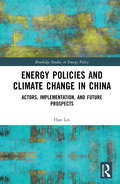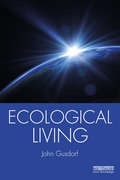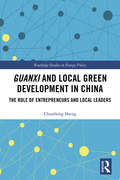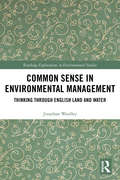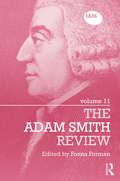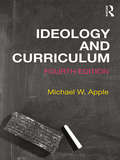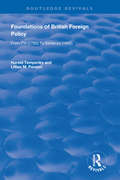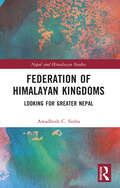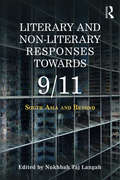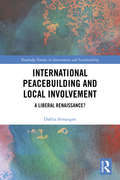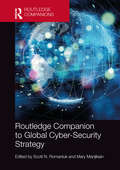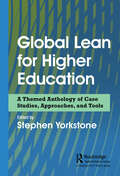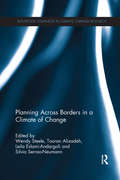- Table View
- List View
Energy Policies and Climate Change in China: Actors, Implementation, and Future Prospects (Routledge Studies in Energy Policy)
by Han LinIn the face of growing environmental challenges, including climate change and energy security, countries across the globe are developing new policies and programs to address these challenges, and China is no exception. This book analyses China’s two most significant climate-related energy policies, the Clean Development Mechanism (CDM; including the later Chinese Certified Emission Reduciton – CCER) and the Energy Conservation and Emission Reduction Scheme (ECERS). This work specifically examines the strengths and weaknesses of these policies to highlight the deficiencies and advise how they can be optimised, so China can better achieve its emission reduction goals. It analyses the roles and relationships between relevant actors and identifies how successful their cooperation has been, and what factors have affected it. Importantly, the work draws on a wide range of sources from central ministries to civil society, including interviews with Chinese officials, scholars, energy company managers, environment non-govermental organisation (ENGO) personnel, media reports, and online forum discussions. In doing so, the book not only analyses the thoughts of policymakers, as many works do, but also those implementing the policies and those impacted by the policies. The book concludes by offering detailed and practical solutions to address each specific deficiency in the CDM and ECERS policies, with the aim of providing innovations and alternative approaches to improve current and future policies in China. This book will be of great interest to students, scholars, and policymakers interested in climate change, energy, and Chinese environmental policy and politics.
Energy Policies and Climate Change in China: Actors, Implementation, and Future Prospects (Routledge Studies in Energy Policy)
by Han LinIn the face of growing environmental challenges, including climate change and energy security, countries across the globe are developing new policies and programs to address these challenges, and China is no exception. This book analyses China’s two most significant climate-related energy policies, the Clean Development Mechanism (CDM; including the later Chinese Certified Emission Reduciton – CCER) and the Energy Conservation and Emission Reduction Scheme (ECERS). This work specifically examines the strengths and weaknesses of these policies to highlight the deficiencies and advise how they can be optimised, so China can better achieve its emission reduction goals. It analyses the roles and relationships between relevant actors and identifies how successful their cooperation has been, and what factors have affected it. Importantly, the work draws on a wide range of sources from central ministries to civil society, including interviews with Chinese officials, scholars, energy company managers, environment non-govermental organisation (ENGO) personnel, media reports, and online forum discussions. In doing so, the book not only analyses the thoughts of policymakers, as many works do, but also those implementing the policies and those impacted by the policies. The book concludes by offering detailed and practical solutions to address each specific deficiency in the CDM and ECERS policies, with the aim of providing innovations and alternative approaches to improve current and future policies in China. This book will be of great interest to students, scholars, and policymakers interested in climate change, energy, and Chinese environmental policy and politics.
Ecological Living
by John GusdorfThis book emphasizes how we already have the technologies available, including renewable energy and the ability to recycle most materials, to make ecological living possible and that perceived barriers to energy transitions can be overcome. Human life relies upon two systems: the biosphere and the system that produces our goods and services. Today, these two systems are in conflict, and we all face the question of whether we can stop damaging our environment while still supplying the essential goods and services we have come to depend on. Ecological Living presents an optimistic vision of our future by showing how decoupling the productive system from resource extraction is possible, and how this is a key means of achieving an equitable world within environmental limits. For long-term sustainability, the book argues that we must become more efficient in the use of our resources so that resource extraction, and the accompanying environmental costs, can be reduced. Demonstrating the essential steps towards a just and sustainable world, Ecological Living will be of great interest to all students, academics, and policymakers working in the field of environment and sustainability.
Ecological Living
by John GusdorfThis book emphasizes how we already have the technologies available, including renewable energy and the ability to recycle most materials, to make ecological living possible and that perceived barriers to energy transitions can be overcome. Human life relies upon two systems: the biosphere and the system that produces our goods and services. Today, these two systems are in conflict, and we all face the question of whether we can stop damaging our environment while still supplying the essential goods and services we have come to depend on. Ecological Living presents an optimistic vision of our future by showing how decoupling the productive system from resource extraction is possible, and how this is a key means of achieving an equitable world within environmental limits. For long-term sustainability, the book argues that we must become more efficient in the use of our resources so that resource extraction, and the accompanying environmental costs, can be reduced. Demonstrating the essential steps towards a just and sustainable world, Ecological Living will be of great interest to all students, academics, and policymakers working in the field of environment and sustainability.
Guanxi and Local Green Development in China: The Role of Entrepreneurs and Local Leaders (Routledge Studies in Environmental Policy)
by Chunhong ShengThis book examines the factors which contribute to local green development in China and employs political ecology to analyze the relationship between power and the environment. Specifically, it looks at which actors control access to resources and are therefore able to promote environmental progress. Following the reform and opening-up of China in the 1970s, entrepreneurs and local officials profited economically and politically and formed close relationships, known as guanxi in China. As a result, they have also been criticized as those responsible for the associated ecological damage. This book does not contest this association, but instead argues that the current literature places too much emphasis on their negative influence and the positive influence of their environmental work has been neglected. Building on three case studies where local green development is being pursued, Shanghai Pudong New Area, Baoding, and Wuning, this book shows how local officials and entrepreneurs can also be the crusaders of a greener environment at the local level in China. This book will be of great interest to students and scholars of Chinese studies, with a particular interest in environmental policy and politics, business and society, as well as those interested in sustainable development more broadly.
Guanxi and Local Green Development in China: The Role of Entrepreneurs and Local Leaders (Routledge Studies in Environmental Policy)
by Chunhong ShengThis book examines the factors which contribute to local green development in China and employs political ecology to analyze the relationship between power and the environment. Specifically, it looks at which actors control access to resources and are therefore able to promote environmental progress. Following the reform and opening-up of China in the 1970s, entrepreneurs and local officials profited economically and politically and formed close relationships, known as guanxi in China. As a result, they have also been criticized as those responsible for the associated ecological damage. This book does not contest this association, but instead argues that the current literature places too much emphasis on their negative influence and the positive influence of their environmental work has been neglected. Building on three case studies where local green development is being pursued, Shanghai Pudong New Area, Baoding, and Wuning, this book shows how local officials and entrepreneurs can also be the crusaders of a greener environment at the local level in China. This book will be of great interest to students and scholars of Chinese studies, with a particular interest in environmental policy and politics, business and society, as well as those interested in sustainable development more broadly.
Common Sense in Environmental Management: Thinking Through English Land and Water (Routledge Explorations in Environmental Studies)
by Jonathan WoolleyCommon Sense in Environmental Management examines common sense not in theory, but in practice. Jonathan Woolley argues that common sense as a concept is rooted in English experiences of landscape and land management and examines it ethnographically - unveiling common sense as key to understanding how British nature and public life are transforming in the present day. Common sense encourages English people to tacitly assume that the management of land and other resources should organically converge on a consensus that yields self-evident, practical results. Furthermore, the English then tend to assume that their own position reflects that consensus. Other stakeholders are not seen as having legitimate but distinct expertise and interests – but are rather viewed as being stupid and/or immoral, for ignoring self-evident, pragmatic truths. Compromise is therefore less likely, and land management practices become entrenched and resistant to innovation and improvement. Through a detailed ethnographic study of the Norfolk Broads, this book explores how environmental policy and land management in rural areas could be more effective if a truly common sense was restored in the way we manage our shared environment. Using academic and lay deployments of common sense as a route into the political economy of rural environments, this book will be of great interest to scholars and students of socio-cultural anthropology, sociology, human geography, cultural studies, social history, and the environmental humanities.
Common Sense in Environmental Management: Thinking Through English Land and Water (Routledge Explorations in Environmental Studies)
by Jonathan WoolleyCommon Sense in Environmental Management examines common sense not in theory, but in practice. Jonathan Woolley argues that common sense as a concept is rooted in English experiences of landscape and land management and examines it ethnographically - unveiling common sense as key to understanding how British nature and public life are transforming in the present day. Common sense encourages English people to tacitly assume that the management of land and other resources should organically converge on a consensus that yields self-evident, practical results. Furthermore, the English then tend to assume that their own position reflects that consensus. Other stakeholders are not seen as having legitimate but distinct expertise and interests – but are rather viewed as being stupid and/or immoral, for ignoring self-evident, pragmatic truths. Compromise is therefore less likely, and land management practices become entrenched and resistant to innovation and improvement. Through a detailed ethnographic study of the Norfolk Broads, this book explores how environmental policy and land management in rural areas could be more effective if a truly common sense was restored in the way we manage our shared environment. Using academic and lay deployments of common sense as a route into the political economy of rural environments, this book will be of great interest to scholars and students of socio-cultural anthropology, sociology, human geography, cultural studies, social history, and the environmental humanities.
The Adam Smith Review: Volume 11 (The Adam Smith Review #11)
by Fonna FormanAdam Smith’s contribution to economics is well recognised, but scholars have recently been exploring anew the multidisciplinary nature of his works. The Adam Smith Review is a rigorously refereed annual review that provides a unique forum for interdisciplinary debate on all aspects of Adam Smith’s works, his place in history, and the significance of his writings to the modern world. It is aimed at facilitating debate between scholars working across the humanities and social sciences, thus emulating the reach of the Enlightenment world which Smith helped to shape. This eleventh volume brings together leading scholars from across several disciplines, and offers a particular focus on Smith and Rousseau. There is also an emphasis throughout the volume on the relationship between Smith’s work and that of other key thinkers such as Malthus, Newton, Freud and Sen.
The Adam Smith Review: Volume 11 (The Adam Smith Review #11)
by Fonna FormanAdam Smith’s contribution to economics is well recognised, but scholars have recently been exploring anew the multidisciplinary nature of his works. The Adam Smith Review is a rigorously refereed annual review that provides a unique forum for interdisciplinary debate on all aspects of Adam Smith’s works, his place in history, and the significance of his writings to the modern world. It is aimed at facilitating debate between scholars working across the humanities and social sciences, thus emulating the reach of the Enlightenment world which Smith helped to shape. This eleventh volume brings together leading scholars from across several disciplines, and offers a particular focus on Smith and Rousseau. There is also an emphasis throughout the volume on the relationship between Smith’s work and that of other key thinkers such as Malthus, Newton, Freud and Sen.
Ideology and Curriculum
by Michael AppleSince 1979, Ideology and Curriculum has been a path breaking statement on the relationship between cultural and economic power in education. The new edition of this now classic text has been updated by celebrated author and activist Michael W. Apple to include a full new chapter on the book’s lasting critical agenda in the context of the contemporary conservative climate. A new substantive preface introduces the fourth edition, reflecting on earlier arguments and developments from the intervening years while a concluding interview details the author’s background and continuing efforts toward building a more equitable society. In celebration of the 40th anniversary of its publication, this highly-anticipated new edition firmly situates Ideology and Curriculum as one of the most important education titles of our time.
Ideology and Curriculum
by Michael W. AppleSince 1979, Ideology and Curriculum has been a path breaking statement on the relationship between cultural and economic power in education. The new edition of this now classic text has been updated by celebrated author and activist Michael W. Apple to include a full new chapter on the book’s lasting critical agenda in the context of the contemporary conservative climate. A new substantive preface introduces the fourth edition, reflecting on earlier arguments and developments from the intervening years while a concluding interview details the author’s background and continuing efforts toward building a more equitable society. In celebration of the 40th anniversary of its publication, this highly-anticipated new edition firmly situates Ideology and Curriculum as one of the most important education titles of our time.
Foundations of British Foreign Policy: 1792 – 1902 (Routledge Revivals)
by Lillian M. Penson H. W. V. TemperleyFirst published in 1938, this volume represents a selection of unpublished and published documents dealing with foreign affairs, from the rise of the Younger Pitt to the death of Salisbury. It contains both official papers and private letters; speeches and other public statements of policy. The Editors have had access to a large number of unpublished materials, public and private, so that many of the documents that they have chosen are new and reveal a striking continuity of ideas in British diplomacy, despite opposed parties and even opposing policies.
Foundations of British Foreign Policy: 1792 – 1902 (Routledge Revivals)
by Harold Temperley Lillian M. PensonFirst published in 1938, this volume represents a selection of unpublished and published documents dealing with foreign affairs, from the rise of the Younger Pitt to the death of Salisbury. It contains both official papers and private letters; speeches and other public statements of policy. The Editors have had access to a large number of unpublished materials, public and private, so that many of the documents that they have chosen are new and reveal a striking continuity of ideas in British diplomacy, despite opposed parties and even opposing policies.
Federation of Himalayan Kingdoms: Looking for Greater Nepal (Nepal and Himalayan Studies)
by Awadhesh C. SinhaThis book traces the history and politics of the Greater Nepal movement. It looks at major events in modern South Asia, in and around the Eastern Himalaya region in particular – colonialism, independence and partition, the Chinese aggression in Tibet, formation of Bangladesh, and the merger of Sikkim with India, among others – which deeply affected the nature of democratic movements in Nepal. The volume also studies the role of the monarchy, the demand for Gorkhaland, and the rise of Maoist movements. Further, it sheds light on political participation encompassing Nepalese functionaries, the many political parties, intellectuals and responsible public figures, and the differential influence that these variegated groups had on the movement. Finally, it reassesses the idea of Greater Nepal and offers a critical commentary on its future. The volume will be of great interest to scholars and researchers of international relations, modern history, sociology and social anthropology, politics, South Asian studies, and area studies – especially Nepal and Himalayan studies – as well as policy makers and government think tanks.
Federation of Himalayan Kingdoms: Looking for Greater Nepal (Nepal and Himalayan Studies)
by Awadhesh C. SinhaThis book traces the history and politics of the Greater Nepal movement. It looks at major events in modern South Asia, in and around the Eastern Himalaya region in particular – colonialism, independence and partition, the Chinese aggression in Tibet, formation of Bangladesh, and the merger of Sikkim with India, among others – which deeply affected the nature of democratic movements in Nepal. The volume also studies the role of the monarchy, the demand for Gorkhaland, and the rise of Maoist movements. Further, it sheds light on political participation encompassing Nepalese functionaries, the many political parties, intellectuals and responsible public figures, and the differential influence that these variegated groups had on the movement. Finally, it reassesses the idea of Greater Nepal and offers a critical commentary on its future. The volume will be of great interest to scholars and researchers of international relations, modern history, sociology and social anthropology, politics, South Asian studies, and area studies – especially Nepal and Himalayan studies – as well as policy makers and government think tanks.
Literary and Non-literary Responses Towards 9/11: South Asia and Beyond
by Nukhbah Taj LangahThis book presents a range of analytical responses towards 9/11 through a critical review of literary, non-literary and cultural representations. The contributors examine the ways in which this event has shaped and complicated the relationship between various national and religious identities in contemporary world history. Unlike earlier studies on the topic, this work reconciles both eclectic and pragmatic approaches by analyzing the stereotypes of nationhood and identities while also questioning theoretical concepts in the context of the latest political developments. The chapters focus on discourses, themes, imagery and symbolism from across fiction and non-fiction, films, art, music, and political, literary and artistic movements. The volume addresses complexities arising within different local contexts (e.g., Hunza and state development); surveys broader frameworks in South Asia (representations of Muslims in Bollywood films); and gauges international impact (U.S. drone attacks in Islamic countries; treatment meted out to Muslims in Europe). It also connects these with relevant theories (e.g., Orientalism) and policy perspectives (e.g., Patriotic Act). The authors further discuss the consequences for minorities and marginalization, cultural relativism vs. ethnocentrism, the clash of civilizations, fundamentalism, Islamization and post-9/11 ‘Islamophobia’. This book will be useful to scholars and researchers of South Asian literature, Islamic studies, literary criticism, political sociology, anthropology and cultural studies, those in the media and the general reader.
Literary and Non-literary Responses Towards 9/11: South Asia and Beyond
by Nukhbah Taj LangahThis book presents a range of analytical responses towards 9/11 through a critical review of literary, non-literary and cultural representations. The contributors examine the ways in which this event has shaped and complicated the relationship between various national and religious identities in contemporary world history. Unlike earlier studies on the topic, this work reconciles both eclectic and pragmatic approaches by analyzing the stereotypes of nationhood and identities while also questioning theoretical concepts in the context of the latest political developments. The chapters focus on discourses, themes, imagery and symbolism from across fiction and non-fiction, films, art, music, and political, literary and artistic movements. The volume addresses complexities arising within different local contexts (e.g., Hunza and state development); surveys broader frameworks in South Asia (representations of Muslims in Bollywood films); and gauges international impact (U.S. drone attacks in Islamic countries; treatment meted out to Muslims in Europe). It also connects these with relevant theories (e.g., Orientalism) and policy perspectives (e.g., Patriotic Act). The authors further discuss the consequences for minorities and marginalization, cultural relativism vs. ethnocentrism, the clash of civilizations, fundamentalism, Islamization and post-9/11 ‘Islamophobia’. This book will be useful to scholars and researchers of South Asian literature, Islamic studies, literary criticism, political sociology, anthropology and cultural studies, those in the media and the general reader.
International Peacebuilding and Local Involvement: A Liberal Renaissance? (Routledge Studies in Intervention and Statebuilding)
by Dahlia SimanganThis book interrogates the common perception that liberal peace is in crisis and explores the question: can the local turn save liberal peacebuilding? Presenting a case for a liberal renaissance in peacebuilding, the work interrogates the assumptions behind the popular perception that liberal peace is in crisis. It re-examines three of the cases igniting the debate – Cambodia, Kosovo, and Timor-Leste – and evaluates how these transitional administrations implemented their liberal mandates and how local involvement affected the conduct of their activities. In so doing, it reveals that these cases were neither liberal nor peacebuilding. It also demonstrates that while local involvement is imperative to peacebuilding, illiberal local involvement restores an elite-centred status quo and reinforces or creates new forms of conflict and violence. Using both liberal and critical lenses, the author ultimately argues that the conceptual and operational departure from the holistic and comprehensive origins of liberal peacebuilding in fact paved the way for the liberal peace crisis itself. Drawing on analysis from in-depth field research and interviews, this book will be of much interest to students of peacebuilding, peacekeeping, statebuilding, security studies and International Relations in general.
International Peacebuilding and Local Involvement: A Liberal Renaissance? (Routledge Studies in Intervention and Statebuilding)
by Dahlia SimanganThis book interrogates the common perception that liberal peace is in crisis and explores the question: can the local turn save liberal peacebuilding? Presenting a case for a liberal renaissance in peacebuilding, the work interrogates the assumptions behind the popular perception that liberal peace is in crisis. It re-examines three of the cases igniting the debate – Cambodia, Kosovo, and Timor-Leste – and evaluates how these transitional administrations implemented their liberal mandates and how local involvement affected the conduct of their activities. In so doing, it reveals that these cases were neither liberal nor peacebuilding. It also demonstrates that while local involvement is imperative to peacebuilding, illiberal local involvement restores an elite-centred status quo and reinforces or creates new forms of conflict and violence. Using both liberal and critical lenses, the author ultimately argues that the conceptual and operational departure from the holistic and comprehensive origins of liberal peacebuilding in fact paved the way for the liberal peace crisis itself. Drawing on analysis from in-depth field research and interviews, this book will be of much interest to students of peacebuilding, peacekeeping, statebuilding, security studies and International Relations in general.
Routledge Companion to Global Cyber-Security Strategy
by Scott N. Romaniuk Mary ManjikianThis companion provides the most comprehensive and up-to-date comparative overview of the cyber-security strategies and doctrines of the major states and actors in Europe, North America, South America, Africa, and Asia. The volume offers an introduction to each nation’s cyber-security strategy and policy, along with a list of resources in English that may be consulted for those wishing to go into greater depth. Each chapter is written by a leading academic or policy specialist, and contains the following sections: overview of national cyber-security strategy; concepts and definitions; exploration of cyber-security issues as they relate to international law and governance; critical examinations of cyber partners at home and abroad; legislative developments and processes; dimensions of cybercrime and cyberterrorism; implications of cyber-security policies and strategies. This book will be of much interest to students and practitioners in the fields of cyber-security, national security, strategic studies, foreign policy, and international relations.
Routledge Companion to Global Cyber-Security Strategy
by Scott N. Romaniuk Mary ManjikianThis companion provides the most comprehensive and up-to-date comparative overview of the cyber-security strategies and doctrines of the major states and actors in Europe, North America, South America, Africa, and Asia. The volume offers an introduction to each nation’s cyber-security strategy and policy, along with a list of resources in English that may be consulted for those wishing to go into greater depth. Each chapter is written by a leading academic or policy specialist, and contains the following sections: overview of national cyber-security strategy; concepts and definitions; exploration of cyber-security issues as they relate to international law and governance; critical examinations of cyber partners at home and abroad; legislative developments and processes; dimensions of cybercrime and cyberterrorism; implications of cyber-security policies and strategies. This book will be of much interest to students and practitioners in the fields of cyber-security, national security, strategic studies, foreign policy, and international relations.
Global Lean for Higher Education: A Themed Anthology of Case Studies, Approaches, and Tools
by Stephen YorkstoneHigher education (HE) is amongst the hardest sectors in which to apply lean. Universities resist change, their organizational cultures being far from the manufacturing environment where lean was born. The way HE organizations are structured, funded, and function globally is idiosyncratic; one size is unlikely to fit all. However, the sector is also dynamic and a mature understanding of lean, as a philosophy, led by principles, suggests there are many ways HE could grow through lean. This collection of work reflects the state-of-the-art in the global practical application of lean for higher education. It aims to demonstrate the diverse applications of lean in universities inspiring others to deeply engage with lean thinking in their own unique context and to drive successful, sustainable, lean work. Contributors are both well-known experts in lean HE and up-and-coming practitioners. Authors live globally, in countries such as Australia, Canada, Malaysia, Poland, the UK, and the USA. They represent higher education environments from applied teaching institutions to research-focused universities from 50 years old to more than 800 years old. The collection focuses on lean applied across universities as a whole, often addressing the administrative support or professional services side of how these institutions work. The application of lean is not limited purely to the administration of such organizations but is applied to the primary purpose of universities: teaching and research. This volume is not focused on lean theory. Instead, it discusses how HE institutions have taken lean forward and the lessons learned that others can share and learn from. It is composed of six sections: Starting out, People, Projects, Technology, Sustaining Lean, and Culture. The rich and wide perspectives in this book will enable the reader to understand the many ways that lean thinking is applied in higher education globally. More importantly, this book will help the reader better understand and apply lean in the context of their own work.
Global Lean for Higher Education: A Themed Anthology of Case Studies, Approaches, and Tools
by Stephen YorkstoneHigher education (HE) is amongst the hardest sectors in which to apply lean. Universities resist change, their organizational cultures being far from the manufacturing environment where lean was born. The way HE organizations are structured, funded, and function globally is idiosyncratic; one size is unlikely to fit all. However, the sector is also dynamic and a mature understanding of lean, as a philosophy, led by principles, suggests there are many ways HE could grow through lean. This collection of work reflects the state-of-the-art in the global practical application of lean for higher education. It aims to demonstrate the diverse applications of lean in universities inspiring others to deeply engage with lean thinking in their own unique context and to drive successful, sustainable, lean work. Contributors are both well-known experts in lean HE and up-and-coming practitioners. Authors live globally, in countries such as Australia, Canada, Malaysia, Poland, the UK, and the USA. They represent higher education environments from applied teaching institutions to research-focused universities from 50 years old to more than 800 years old. The collection focuses on lean applied across universities as a whole, often addressing the administrative support or professional services side of how these institutions work. The application of lean is not limited purely to the administration of such organizations but is applied to the primary purpose of universities: teaching and research. This volume is not focused on lean theory. Instead, it discusses how HE institutions have taken lean forward and the lessons learned that others can share and learn from. It is composed of six sections: Starting out, People, Projects, Technology, Sustaining Lean, and Culture. The rich and wide perspectives in this book will enable the reader to understand the many ways that lean thinking is applied in higher education globally. More importantly, this book will help the reader better understand and apply lean in the context of their own work.
Planning Across Borders in a Climate of Change (Routledge Advances in Climate Change Research)
by Wendy Steele Tooran Alizadeh Leila Eslami-Andargoli Silvia Serrao-NeumannThe fixity or mobility of borders are key themes within the border studies literature and have useful critical application to urban and environmental planning through theory, pedagogy and practice. This offers potential for transformative change through the processes of re-bordering and re-orienting established boundary demarcations in ways that support and promote sustainability in a climate of change. Planning Across Borders in a Climate of Change draws on a range of diverse case studies from Australasia, North and South America, Europe, Africa, the Middle East and Asia and offers the application of border theory, concepts and principles to planning as a critical lens. It applies this lens to a range of international case studies in key areas such as climate change adaptation, food security, spatial planning, critical infrastructure and urban ecology. This collection fills an important gap in the border studies literature, bringing climate change considerations to bear on planning. It should be of interest to students, scholars and professionals in the field of urban and environmental planning, climate change adaptation, border studies, urban studies, human and political geography, environmental studies and development.
